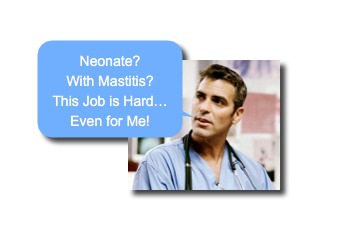Neonatal Mastitis

Neonatal Breast Enlargement
- Neonatal breast enlargement is a common and normal finding. [Masoodi, 2014]
- At the end of pregnancy, the falling levels of estrogen can trigger a release of prolactin from the newborn’s pituitary.
- Leads to breast enlargement in ~70% of neonates.
- Typically affects: [Masoodi, 2014]
- Full Term infants (premature infants have less well developed breast tissue)
- Both males and females equally.
- Neonates during in the first week of life.
- May last longer in females.
- Some will demonstrate discharge from the nipple.
- This should be milky or clear fluid.
- Often referred to as “Witch’s Milk” – but let us not be judgmental.
- The condition is self-limited and warrants only observation.
- Observation for signs of developing infection.
- Can become complicated by infection and abscess formation.
Neonatal Mastitis: Basics
- Mastitis, as the name would imply, is an infection of the breast tissue.
- Unlike normal breast enlargement in a neonate, mastitis will be: [Masoodi, 2014; Sloan, 2003]
- Red
- Painful
- More likely in females (2:1)
- Purulent discharge from nipple
- Most often unilateral [Sloan, 2003]
- Potentially associated with suppurative lesions elsewhere [Masoodi, 2014]
- Typically seen in 2nd – 8th week of life. [Masoodi, 2014; Ruwaili, 2012; Sloan, 2003]
- Uncomplicated Mastitis is usually earlier (2nd – 3rd week).
- Abscesses have been seen in 3rd and 4th week of life.
- It has been found to most often a localized process. [Masoodi, 2014]
- Occurs in well appearing infants without systemic symptoms.
- 8-28% have presented with systemic symptoms. [Masoodi, 2014; Sloan, 2003]
- Fever, vomiting, lethargy or irritability are uncommon. [Ruwaili, 2012]
- Blood cultures and CSF cultures, when done, have not proven to be positive in reported cases. [Masoodi, 2014; Ruwaili, 2012]
- Occurs in well appearing infants without systemic symptoms.
- Most often it is associated with S. aureus.
- May also see Group B Strep, Gram-negative enteric, or anaerobic bacteria.
Neonatal Mastitis: Management
- 1st – Don’t call normal neonatal breast enlargement “mastitis.”
- 2nd – Don’t trust a neonate, but…
- 3rd – Be reasonable though.
- While remaining vigilant and not trusting the neonate, it has been well documented that neonates with isolated mastitis do well with limited work-up and antibiotics. [Masoodi, 2014; Ruwaili, 2012]
- There is no standard approach with respect to “full-sepsis work-up” vs “limited-sepsis work-up.” [Ruwaili, 2012]
- Not trusting the neonate, certainly warrants a more conservative approach, but again, this is usually localized pathology.
- There is significant variation in physician’s management of mastitis. [Ruwaili, 2012]
- There is also no standard approach with respect to IV antibiotics vs oral (Inpatient vs Outpatient). [Ruwaili, 2012]
- Most studies to show a higher prevalence of inpatient IV antibiotics over outpatient management.
- Oral antibiotics may have poor bioavailability in the neonatal period.
- Personally, a neonate with a “suspected” infection makes me nervous… one with a KNOWN infection makes me diaphoretic.
- The available evidence, though, would note that the non-toxic infant without systemic symptoms presenting with mastitis does not benefit from extensive testing. [Ruwaili, 2012]
- Gram stain and Culture of any nipple discharge fluid will not likely help during the initial evaluation, but may be beneficial if there is treatment failure.
- While abscesses typically require incision and drainage, there is evidence that trial of antibiotics is reasonable prior to either needle aspiration or incision and drainage of neonatal mastitis. [Sloan, 2003]
Moral of the Morsel
- Never trust a neonate. Just simply, never trust a neonate, but you can be reasonable.
- Breast enlargement in a neonate is normal. Breast infection is not. Mastitis requires antibiotics.
- If giving a neonate antibiotics, ask yourself whether you need to worry about disseminated infection.
References
Masoodi T1, Mufti GN2, Bhat JI3, Lone R1, Arshi S1, Ahmad SK1. Neonatal mastitis: a clinico-microbiological study. J Neonatal Surg. 2014 Jan 1;3(1):2. PMID: 26023473. [PubMed] [Read by QxMD]
Al Ruwaili N1, Scolnik D. Neonatal mastitis: controversies in management. J Clin Neonatol. 2012 Oct;1(4):207-10. PMID: 24027728. [PubMed] [Read by QxMD]
Borders H1, Mychaliska G, Gebarski KS. Sonographic features of neonatal mastitis and breast abscess. Pediatr Radiol. 2009 Sep;39(9):955-8. PMID: 19506847. [PubMed] [Read by QxMD]
Faden H1. Mastitis in children from birth to 17 years. Pediatr Infect Dis J. 2005 Dec;24(12):1113. PMID: 16371879. [PubMed] [Read by QxMD]
Sloan B1, Evans R. Clinical pearls: neonatal breast mass. Acad Emerg Med. 2003 Mar;10(3):269-70. PMID: 12615593. [PubMed] [Read by QxMD]
Efrat M1, Mogilner JG, Iujtman M, Eldemberg D, Kunin J, Eldar S. Neonatal mastitis–diagnosis and treatment. Isr J Med Sci. 1995 Sep;31(9):558-60. PMID: 7558780. [PubMed] [Read by QxMD]
Tzen KT, Wu WH, Shih HY. Mastitis neonatorum. Zhonghua Min Guo Xiao Er Ke Yi Xue Hui Za Zhi. 1989 Jul-Aug;30(4):248-53. PMID: 2637605. [PubMed] [Read by QxMD]


good job well done
There is significant disagreement among clinicians regarding the best way to treat the well-looking neonate with localized mastitis. Most elect to perform blood tests and start treatment with IV antibiotics with good Staphylococcus aureus coverage, followed by oral antibiotics if cultures are negative.